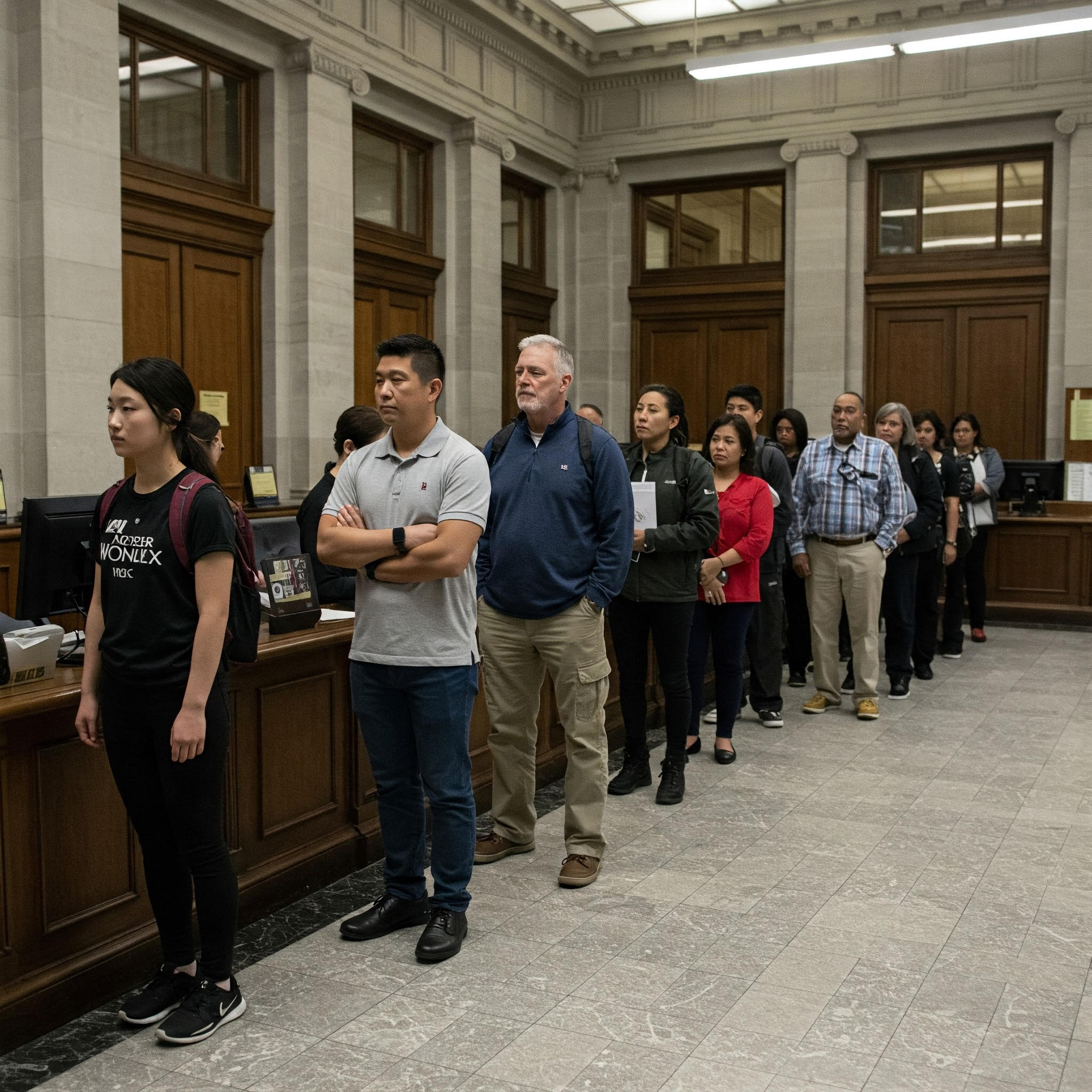Waiting in long lines at government offices is a common frustration. Studies showed that people wait at least 45 minutes in a long queue to complete their work. That’s a long time to stand in a line. A modern digital queue management system and smart scheduling tools can transform this experience.
Instead of waiting in long lines, people can easily book their slots using their phones. AI-powered government queue management systems provide real-time queue updates with notifications to people, which helps citizens wait conveniently until their turn arrives. This ensures quick service delivery, less crowding, and improved citizen experience.
In this blog, we will further explore
- Reasons for Long Wait Times at Government Offices
- Effective digital solutions to remove long queues and improve citizens’ experience
- The benefits of adopting smart queue management technology
We will learn how better queue management helps government officials do their jobs better and makes public services faster and more efficient.
The Real Reasons Behind Long Queues in Government Offices
Before we fix the problem, let’s understand why long lines happen in the first place.
1. Outdated Manual Processes
Many government offices still use paper-based systems. Instead of booking appointments online, people had to wait hours to submit a form.
2. Overcrowded Service Centers
When too many people arrive at the same time, offices get packed. Staff members find it difficult to control the crowd without a digital queue management system, which causes delays.
3. Limited Staff Resources
Government offices often have too few employees handling too many requests. Without smart tools, workers spend time organizing lines instead of helping citizens.
The result? Frustrated customers! Long wait times, sometimes even extended up to hours, resulted in angry citizens, and they left the office without getting any help. The government needed an effective way to reduce wait times in government offices and increase staff productivity. That’s when digital queue management systems came to the rescue to transform the citizen experience.
Smart Ways Government Offices Are Reducing Wait Times
With the help of the latest tools and technology, people are no longer required to wait in long lines to get their work done. Smart queue management systems are helping government offices serve people better and increase staff productivity by:
1. Allowing Online Appointment Scheduling
Online appointment scheduling lets people book their slots in line using their phones. This reduces overcrowding at the counters and ensures everyone’s request is taken care of. With the help of this feature, citizens can book their slots according to their comfort and the time that suits them the best. Smart queues assign token numbers to ensure clear order and prevent confusion among staff. This not only improves everyone’s experience but also simplifies daily operations for staff to ensure better productivity.
2. Self-Service Kiosks
Self-service kiosks are digital touchscreens that let people select their services themselves without any human help. These machines are very easy to use and have very simple navigation buttons. When a citizen arrives, they can check in via a kiosk, and it displays the office’s services. Once booked, it generates the expected wait times and tokens for people. This lets citizens complete document submissions or fee payments independently. Kiosks make service faster and reduce employee workload.
3. Mobile Apps & SMS Alerts
Once checked in via phones or kiosks, these smart apps can automatically send real-time notifications to people regarding their wait times. These notifications keep people updated on their upcoming appointments or tell them when it’s their turn. These messages help reduce no-shows and provide real-time updates on queue status and estimated wait times.
4. AI-Powered Analytics
Smart tracking tools monitor how busy the office is and help staff plan better. It provides a data report predicting the office’s busy hours and the number of people expected in the office in the upcoming hours. These reports can help administrative staff to allocate officials accordingly or open more counters if needed. Digital government services simplify lives.
With these solutions, government offices are becoming faster, smarter, and more helpful every day.
How Smart Queues Make Government Services Better
Long lines—especially in government offices—can frustrate people. To reduce customer frustrations, government offices are adapting to new technologies to serve people better. Digital queue management systems help offices serve people better. It’s a smart way to help people wait conveniently without standing in line for too long. Choosing a smart queue solution is a great decision as it helps in:
1. Shorter queues & happier citizens
Digital queues let people check in virtually using their phones. They can conveniently choose their preferred time slots and services from their homes. There is no need to wait in long lines, as they can receive a message on their phones about queue updates. This automatically reduces overcrowding, resulting in happier citizens and efficient service delivery for staff.
2. Increased Staff Productivity
When lines are shorter and well organized, it helps the office staff to provide the best services to the citizens. They don’t have to manage the queue manually, which frees up their time for other important tasks. When citizens use digital systems for their bookings, it reduces the chances of double bookings; otherwise, this problem consumes most of the staff’s time to reschedule meetings.
3. Better Accessibility
It is hard to wait in long lines. People, especially senior citizens or citizens with disabilities, find it easy to book their appointments in advance so they don’t have to wait in long queues. The system supports multiple languages with a very user-friendly interface so everyone can use it. Making services easy for everyone shows care, and that’s when people show interest in services.
4. Lower Operational Costs
When offices use cloud-based queue management systems, fewer staff are required to manage the lines. This way, offices can save money by preventing overstaffing.
Government offices that use these systems have shorter queues, happier citizens, better staff performance, and more trust from the public. It’s a win for everyone!
Conclusion
Digital tools are making a big difference in government offices. They help people avoid long lines and save time. Now, citizens can book their visits from home, check in with their phones, and get messages when it’s their turn. This means less waiting, less stress, and faster help. Staff can do their jobs more easily and help more people. There is less mess, fewer problems, and more happy faces.
These Smart queue systems for public offices are easy to use, even for older people or those with special needs. They also help save money and improve service.
Is your government office still relying on manual queues? It’s time to upgrade. Explore digital queue management solutions and give citizens the experience they deserve. Government queue management systems make things better for everyone. People get quick service. Staff work smarter. Offices run smoother. It’s a smart move that every government office should make to serve citizens better and faster.










